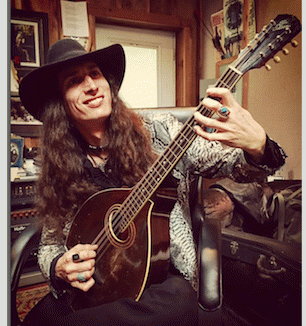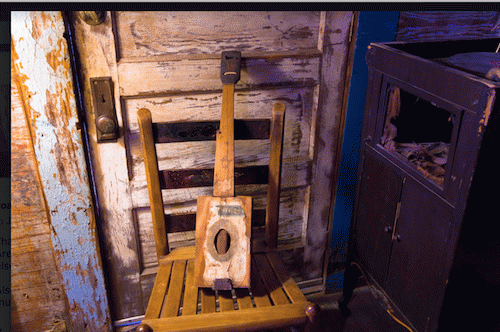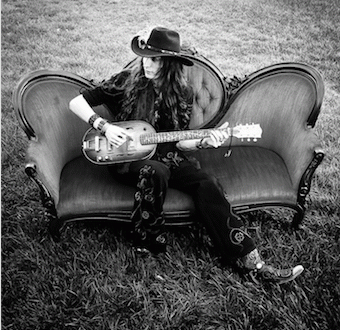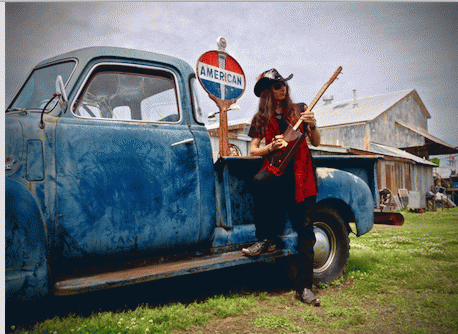My guest today is Nashville-based guitarist, Justin Johnson, who has a unique approach to music. Welcome to OpEdNews, Justin.
Joan Brunwasser: I ruefully admit that I was not familiar with your work until a colleague sent me your YouTube video "Three Strings and a Shovel" and I was smitten. I'm pretty sure that many of our readers have not had the opportunity to hear you - yet. Let's fill them in. First, tell us about how music became part of your life, please.
Justin Johnson: Music has always been an important part of my family. My grandfather played the trumpet professionally and conducted music his whole life. My mom has always loved music, and has DJ'd for the past fifteen years. My brother has played guitar longer than I have, and some of my first experiences playing the 6-string were watching him and his friends play in Seattle; trying to pick up chords and riffs where I could. About a year after I got my first electric guitar, I was gigging, and it's been my life ever since. I think some part of me knew that music was going to be "IT" for me" it was my first job, and has always been my passion and full-time career.

Crankin' Up the 3-String Shovel Guitar!
(Image by Justin Johnson, Channel: Justin Johnson) Details DMCA
JB: Cool! I've heard you play bluegrass but I also know that's not the sum total of your repertoire. You've gone through a number of styles and genres. Can you talk about that evolution a bit?
JJ: To me, it's very exciting to take traditional styles like Blues, Roots, Bluegrass, Gospel, etc. and use that musical vocabulary to create something new and meaningful. My own personal tastes are very diverse, and I try to represent that in the music that I write and perform. That way, I'm keeping it fresh for myself, and for the audience. Some of my favorite artists are those that never put out the same album twice, in the sense that each new project adds a new dimension to their sound, but they retain that "spirit" that makes them who they are artistically. That's my goal as an artist: to be diverse, but to maintain a voice and style that is distinctly "Justin Johnson."
Roots Music is a broad term that refers to the early traditional music of any culture that becomes the foundation for later musical styles. The term "Roots" is also used as a means to describe the act of keeping a musical style true to its early formative stages, and stripping away purely modern or superficial influences.
Roots Instruments are musical instruments that are created using the traditional philosophy of taking whatever objects or construction methods happen to be available regionally or culturally, and making improvised musical instruments from them. The materials for making Roots Instruments can include practically anything, ranging from natural objects such as animal, plant, or stone components, to manufactured objects such as boxes, discarded metal, tools, parts of dismantled instruments, etc.As roots traditions from the past are embraced by modern day instrument builders and players, you see the merging of traditional building styles and materials with components with approaches and components that that weren't available in the past...for example, rudimentary builds blended with modern electronics. In this way, those roots traditions are kept alive and growing...like any healthy root!
JB: I believe you've been quite successful in that goal. Your quest has led you down some unconventional paths. For instance, how did "Three Strings and a Shovel" come about? I'm sure our readers will be intrigued to learn more.
JJ: My unique approach to music has created a culture around what I do, in that I'm contacted on a regular basis by instrument builders and artists of every ilk, who ask to put instruments in my hands to see what I can do with them, everything from the most rudimentary builds to the finest custom shop instruments. Some of the most memorable performances are the ones that arise spontaneously, and this 3-String Shovel performance is a great example of that. I just went out onto the deck in my backyard, overlooking Old Henderson Lake, and started picking around for fun. My fiancee happened to have a camera, and now that moment is famous worldwide!
JB: Great catch! Then, there's the cigar box guitar. What can you tell us about that?
JJ: My introduction to the Cigar Box Guitar came about in a very similar way. When I first began touring as a soloist, I was performing on conventional electric and acoustic guitars. At one of my concerts, the owner of the venue approached me with a cigar box guitar that he had for sale at the venue, and asked if I would play it. At the time, I had never played anything like it. It was a 4-string, and I was used to 6-string guitars, so I just made up a tuning, pulled out my guitar slide, and started to improvise. The feeling of that roots instrument really opened up a flow of new musical inspiration for me, even in that first performance. It stripped away a lot of patterns and "go-to" riffs that I was used to playing, and forced me to dig a little deeper to find the music. The result was a much more personal and "in-the-moment" vibe.
The more I learned about cigar box guitars, the more I realized that they are just one small part of a tradition that includes all roots instruments; instruments that were made out of found objects and designed by people who may not have had the ability to buy or borrow a conventional instrument. When you think about those types of instruments in broader terms, you realize that all instruments originated in this humble way, and that playing roots instruments is a way of reaching back in time, and tapping into that original musical wellspring. To me, that's what roots music, and roots instruments, are all about.
JB: How is a cigar box guitar made? How does it achieve such a deep and rich resonance? Is it much less expensive than a traditional version of same? I'd like to know more and I have a strong feeling that our readers would, too.
JJ: A cigar box guitar is made however you want it to be made. No matter how hard some people might try to standardize roots instruments, they will always evade being "put in a box." Historically, the fiddle and banjo were the most popular cigar box instruments being made. The first published plans for a cigar box guitar were for a banjo, which was a much more popular stringed instrument back in the mid-1800s. In the 1920s, when ukuleles were at the peak of their popularity, you saw a flood of cigar box ukulele designs. Before the 1940s, most stringed instruments were strung up using gut strings, but with the development of steel strings during and after WWII, you saw cigar box instrument design branch out into a myriad of inventive directions.
Some cigar boxes, especially the older wooden ones, have a remarkably beautiful tone. They don't project as loudly as conventional acoustic guitars, banjos and fiddles, but they have a muted, dry, lonesome tone that is impossible to get from even the nicest acoustic guitar. From an engineering perspective, the cigar box is a pretty bad resonating body. There is less sustain, less responsiveness in the bass frequencies, and little structural integrity to the box itself, but these random elements all contribute to the uniqueness of the tone. The same holds true for any object that can be turned into a guitar, whether a washtub, a license plate, a stove pipe, or a turtle shell!
As far as prices go, very humble roots instruments can be made for almost nothing. I have a video on YouTube where I built a one-string diddley bow (a traditional one-stringed slide guitar) in 20 minutes using nothing but found objects in a garage. It sounded great! Most roots instruments are more affordable than their conventional counterparts, but it all depends on what you are looking for. There are some amazing luthiers building roots instruments that are every bit as high-quality as some of the classic custom-shop instruments out there. I'm always happy to help point people in the right direction for where to find a great instrument, if they contact me through my website.
JB: Thanks for that morsel of folk history. Would you say that roots instruments are seeing a surge in interest these days? And if so, is the internet at least part of the reason for any increased familiarity with that music form?
JJ: With the internet's ability to connect people and bridge geographical gaps, it's definitely a lot easier for like-minded instrument makers to connect with each other over their common interests. I've seen that this applies to all instrument building, not just roots instruments. But I feel that the interest has always been there, flying under the radar. It's just more obvious, when looking at it today, because it's easier to find with an internet search. For example, I was in a used bookstore in St. Louis last year, and found three books, all published before the 1990s, that focused on roots instrument building, in that one bookstore alone. Plans for homemade instruments have always been very popular subjects for woodworking and crafter publications. I believe that the internet is just the modern day equivalent of something that has been happening in every generation.
Bo Diddley cut his musical teeth performing on homemade electric guitars. Many of the Blues greats like Elmore James, B.B. King, Lightnin' Hopkins, Blind Willie Johnson, Buddy Guy, etc., started with homemade roots instruments. When you think about it, the first instruments ever made were improvised, DIY instruments from found objects. Eventually the design of those homemade instruments was refined and mass produced to become what we consider "conventional" instruments today. The electric guitar started out as a project in Les Paul's workshop. It seems to me that roots instrument building always seems to contain the diamond in the rough, of the next big step in musical progress.
JB: When you perform, do you take a bunch of instruments with you? What do you take? And, how do you decide what to play on what?
JJ: Like most things that have to do with music, art, and performance, the wisest voice to follow is the one that is speaking the loudest in the moment. Since I perform as a soloist, I can change the entire show from day-to-day and not have to worry about whether the rest of the band knows what I'm planning. This is essentially how I choose what instruments I perform with. When preparing for a show, I grab a small arsenal of the stringed instruments that are speaking to me in the moment "sometimes a dozen or more for a single show. Then I will write out a loose set list, knowing which instruments will play which parts. I like to construct the skeleton of the show ahead of time, but all of the meat of the show is decided based on the interactions and energy from the room and the crowd.
JB: What a wonderfully organic show you must put on! Very improv, no? What haven't we talked about yet?
JJ: Absolutely, improv is a huge part of my shows, my studio sessions, and my way of life. I feel like the true magic of music as a form of emotional communication requires some malleability. You must be present in the moment, in order to truly communicate a sincere message of how you feel when those strings are touching your fingers. Before I perform anything, I try to center and ground myself in the present moment. The last thing I ever want is to try to reproduce something that's been done before, either by another artist, or even myself. I've found over the years on stage that those impromptu moments of true present-moment expression are what carry the deepest and most profound messages to the listener.
This concept carries over to both solo performances and performances with other artists. Right now I am between studio sessions, working on my newest album, "Drivin' It Down!" This project will showcase the talents of many guest artists, and much of the album will be based around the magic that happens when a group of musicians all have room to improvise in the moment with one another. One musician will add an accent or inflection that will then influence the next musician's musical direction" soon, the song will take a completely new and unexpected direction. It's like the musical butterfly effect.
You can find out more about my "Drivin' It Down!" album, and the current Kickstarter Campaign that I'm running in order to independently fund it, at the following link.
JB: Great. Good luck with "Drivin' It Down!" It's been such fun learning about you and your music, Justin. Thanks so much for talking with me.
***
Readers, take note: November is Positive Music Month.
See Meryl Ann Butler's article, Need A Dose of Positivity?
****
YouTube: Justin Johnson Introduces the Cigar Box Guitar
YouTube: An original song called "Loose Change" that will be on my next album
YouTube: "Baby Don't You Tear My Clothes" played on an Ironing Board Lap Steel
Also:
Justin's website
Roots Music School website
Justin's YouTube Channel
Justin's FaceBook Page









